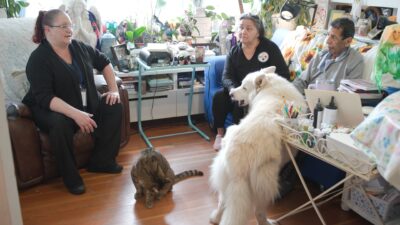The first week of at-home hospice care can bring a flurry of unanticipated activity. However, the pace of visits will generally slow after the first few days and begin to follow a predictable routine.
Hospice care is provided by an interdisciplinary team of professionals with experience in end-of-life care. These typically include a hospice physician, registered nurse, hospice aide, social worker and, if desired, a chaplain or spiritual counselor.

Once the patient has been evaluated and admitted to hospice, team members visit to introduce themselves and describe the services they provide.
Team members also explain how they can support the patient’s end-of-life goals alongside the family or friends who are providing home-based care. For example, they will give caregivers a phone number to call, day or night, to reach a hospice provider who can address urgent questions or concerns.
The first days of hospice
The hospice team develops a comprehensive, personalized plan for end-of-life care. The plan is designed to meet the patient’s immediate medical, physical, spiritual, and psychosocial needs; anticipate future care requirements; and assess the needs of the patient’s caregivers.
During the first days of hospice:
- Durable medical equipment is ordered, delivered, and installed. This may include a hospital bed, bedside commode, Hoya lift, oxygen concentrator, and/or other items.
- Personal hygiene supplies are delivered, including incontinence pads, skin cleansers, and soothing lotions.
- Supplies needed by the hospice aide are delivered, including plastic basins, disposable gloves, and bathing wipes.
- Medications are ordered. The nurse orders necessary medications after consulting with the hospice physician. Some hospices also order a “comfort care” pack to be used by caregivers if the patient’s symptoms change rapidly and immediate clinical help or pharmaceuticals are not available.
Instructions are provided by the hospice nurse, so family caregivers understand how to provide care and administer/monitor medications properly and safely.
Routine hospice care
After the first few days, the pace of visits generally slows and they begin to follow a predictable routine. Each patient’s care plan will vary, but a typical schedule might look like the one below.
Regular visits:
- A hospice aide visits three times a week to help with hygiene and other personal care. For example, they may help the patient bathe or give the patient a sponge bath.
- A registered nurse (RN) visits regularly to monitor the patient’s medical condition. This may include assessing pain, medication needs, and overall health status. Visits may occur weekly or more frequently; Medicare requires an RN to visit at least once every 14 days.
As-needed visits:
- A hospice social worker is likely to visit shortly after care begins to see if the patient or family has practical or psychosocial needs that should be addressed.
- A hospice chaplain or spiritual counselor is scheduled to visit if the patient or family wishes to discuss faith or spiritual concerns.
- A nurse practitioner (NP) or physician assistant (PA) visits to assess ongoing eligibility for hospice or acute changes in the patient’s medical condition. The NP or PA may revise the patient’s care plan, including changing medications, in collaboration with the medical doctor directing the patient’s care.
A hospice medical doctor (MD) oversees the patient’s care and ongoing eligibility along with another physician — usually the patient’s primary care physician or the hospice provider’s attending physician. Routine visits by the MD or hospice physician are not common, however; the NP or PA will collaborate with the MD and other team members when changes to the care plan are needed.
Volunteer services
Services provided by volunteers are an important part of the Medicare hospice benefit. These services are available to all patients receiving hospice care, although their frequency varies depending on the hospice provider.
Volunteer services may include:
- Home-making assistance.
- Companionship.
- “Respite care” that gives family caregivers time off during the day.
- Aromatherapy, music therapy, or pet therapy.



